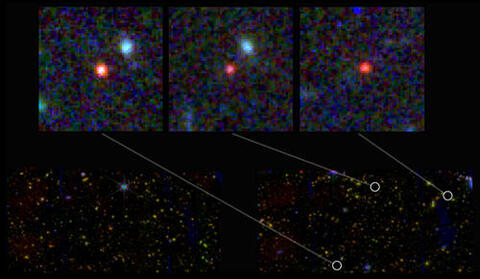Early universe may be ‘teeming’ with bright galaxies, new data reveals

The Milky Way just learned it has a bunch of much older siblings.
New data from the James Webb Space Telescope (JWST) has revealed that the universe produced star-filled galaxies much earlier than previously thought. This discovery, if confirmed, is likely to provoke a major rethinking of the timing and dynamics of galaxy formation — and, perhaps, the number of stars with Earth-like planets that have developed, according to an international research team that included Yale.
“The JWST images seem to tell us there were galaxies with just as many stars as the Milky Way when the universe was in its infancy,” said Yale astronomer Pieter van Dokkum, co-author of a new Nature study describing the findings. He is the Sol Goldman Family Professor of Astronomy and professor of physics in Yale’s Faculty of Arts and Sciences.
The study is based on the first images taken with the Near Infrared Camera (NIRCam) on JWST as part of the Cosmic Evolution Early Release Science (CEERS) program. Astronomers compared the new imaging with previous data from the Hubble Space Telescope.
In the new study, the researchers identify six galaxies as potentially having a similar number of stars as the Milky Way, Earth’s home galaxy. Considering their age, these newly spotted galaxies will likely evolve into the biggest, most massive galaxies in the universe, the researchers added.
Until now, the earliest known galaxies with brightness comparable to the Milky Way date back to 1 billion years after the Big Bang. But thanks to JWST’s more powerful instruments, astronomers are pulling back the cosmic curtain to reveal new insights.
The six newly identified galaxies would have existed 500 to 700 million years after the Big Bang, the researchers said.
In addition, the researchers found another seven new galaxies from this time period with only slightly fewer stars than the Milky Way.
“It was a real shocker to us, when we saw the data,” van Dokkum said. “I think it is an important element in the overall story that has emerged from the early JWST results, that galaxy formation started earlier than we thought. No one knew what JWST would find. Excitingly, the early universe, which JWST unlocked, appears to be teeming with bright galaxies.”
The researchers’ next step will be to verify the findings via spectroscopy, which measures the spectrum of electromagnetic radiation, such as X-rays, radio waves, and visible light.
The first author of the new study is Ivo Labbé of the Swinburne University of Technology, in Australia.
Story written by Jim Shelton, YaleNews.
